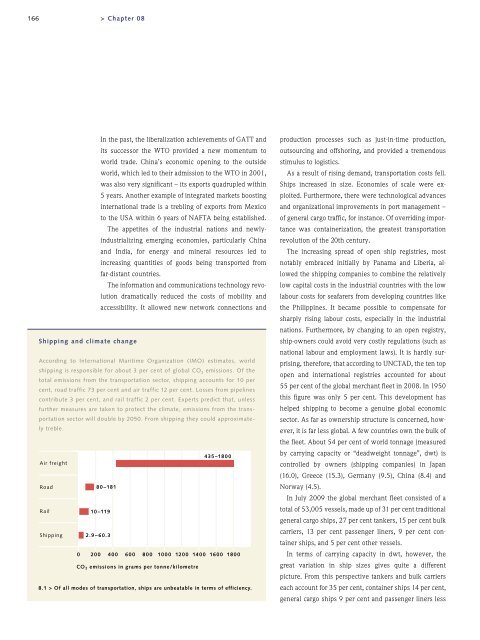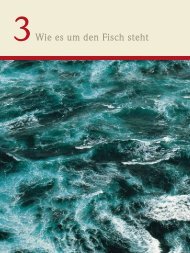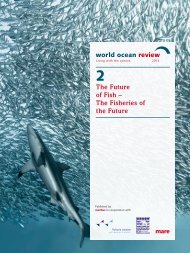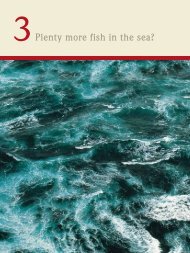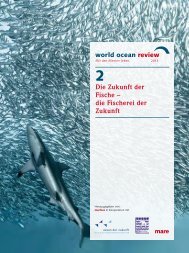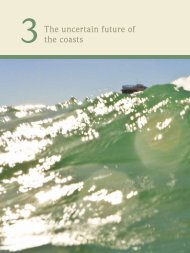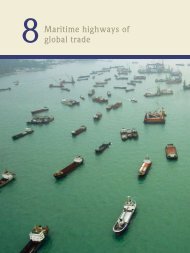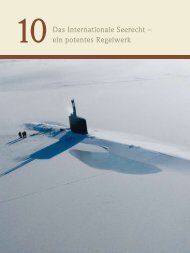Download PDF > WOR 1 - World Ocean Review
Download PDF > WOR 1 - World Ocean Review
Download PDF > WOR 1 - World Ocean Review
Create successful ePaper yourself
Turn your PDF publications into a flip-book with our unique Google optimized e-Paper software.
166> Chapter 08In the past, the liberalization achievements of GATT andits successor the WTO provided a new momentum toworld trade. China’s economic opening to the outsideworld, which led to their admission to the WTO in 2001,was also very significant – its exports quadrupled within5 years. Another example of integrated markets boostinginternational trade is a trebling of exports from Mexicoto the USA within 6 years of NAFTA being established.The appetites of the industrial nations and newlyindustrializingemerging economies, particularly Chinaand India, for energy and mineral resources led toincreasing quantities of goods being transported fromfar-distant countries.The information and communications technology revolutiondramatically reduced the costs of mobility andaccessibility. It allowed new network connections andShipping and climate changeAccording to International Maritime Organization (IMO) estimates, worldshipping is responsible for about 3 per cent of global CO 2emissions. Of thetotal emissions from the transportation sector, shipping accounts for 10 percent, road traffic 73 per cent and air traffic 12 per cent. Losses from pipelinescontribute 3 per cent, and rail traffic 2 per cent. Experts predict that, unlessfurther measures are taken to protect the climate, emissions from the transportationsector will double by 2050. From shipping they could approximatelytreble.435–1800Air freightRoadRailShipping80–18110–1192.9–60.30 200 400 600 800 1000 1200 1400 1600 1800CO 2 emissions in grams per tonne/kilometre8.1 > Of all modes of transportation, ships are unbeatable in terms of efficiency.production processes such as just-in-time production,outsourcing and offshoring, and provided a tremendousstimulus to logistics.As a result of rising demand, transportation costs fell.Ships increased in size. Economies of scale were exploited.Furthermore, there were technological advancesand organizational improvements in port management –of general cargo traffic, for instance. Of overriding importancewas containerization, the greatest transportationrevolution of the 20th century.The increasing spread of open ship registries, mostnotably embraced initially by Panama and Liberia, allowedthe shipping companies to combine the relativelylow capital costs in the industrial countries with the lowlabour costs for seafarers from developing countries likethe Philippines. It became possible to compensate forsharply rising labour costs, especially in the industrialnations. Furthermore, by changing to an open registry,ship-owners could avoid very costly regulations (such asnational labour and employment laws). It is hardly surprising,therefore, that according to UNCTAD, the ten topopen and international registries accounted for about55 per cent of the global merchant fleet in 2008. In 1950this figure was only 5 per cent. This development hashelped shipping to become a genuine global economicsector. As far as ownership structure is concerned, however,it is far less global. A few countries own the bulk ofthe fleet. About 54 per cent of world tonnage (measuredby carrying capacity or “deadweight tonnage”, dwt) iscontrolled by owners (shipping companies) in Japan(16.0), Greece (15.3), Germany (9.5), China (8.4) andNorway (4.5).In July 2009 the global merchant fleet consisted of atotal of 53,005 vessels, made up of 31 per cent traditionalgeneral cargo ships, 27 per cent tankers, 15 per cent bulkcarriers, 13 per cent passenger liners, 9 per cent containerships, and 5 per cent other vessels.In terms of carrying capacity in dwt, however, thegreat variation in ship sizes gives quite a differentpicture. From this perspective tankers and bulk carrierseach account for 35 per cent, container ships 14 per cent,general cargo ships 9 per cent and passenger liners less


